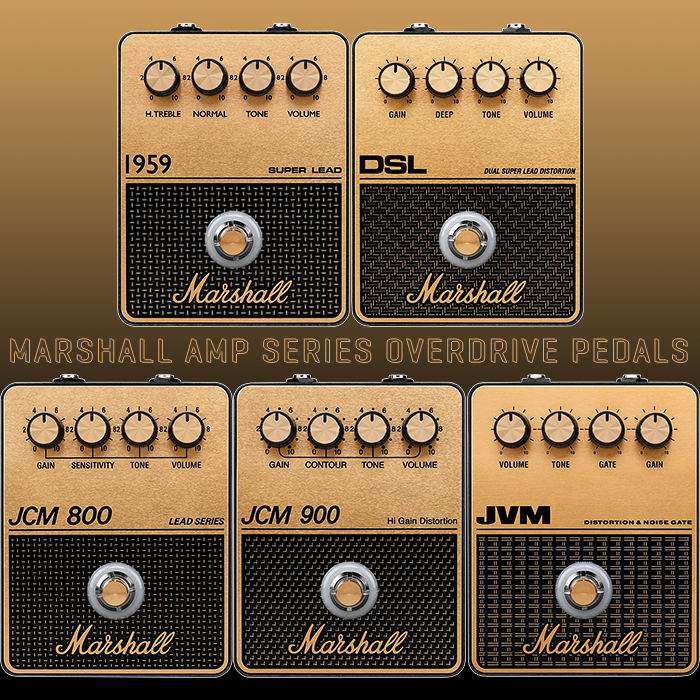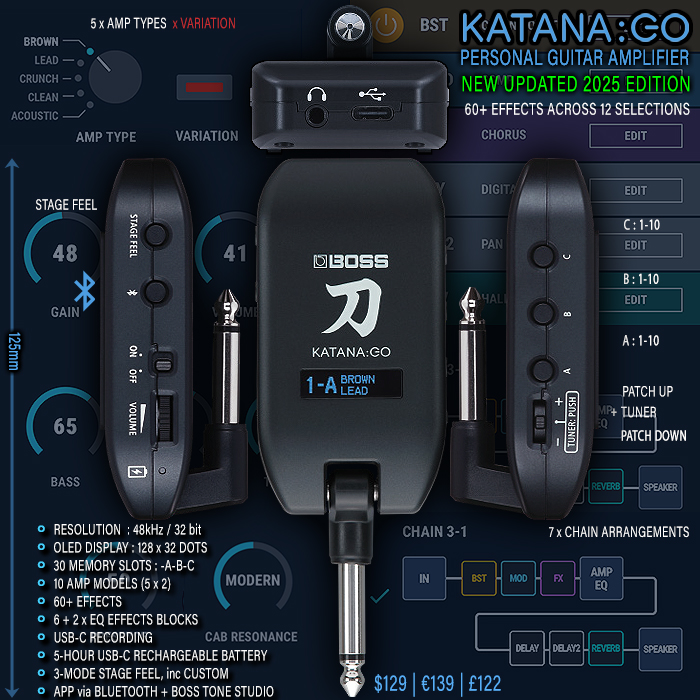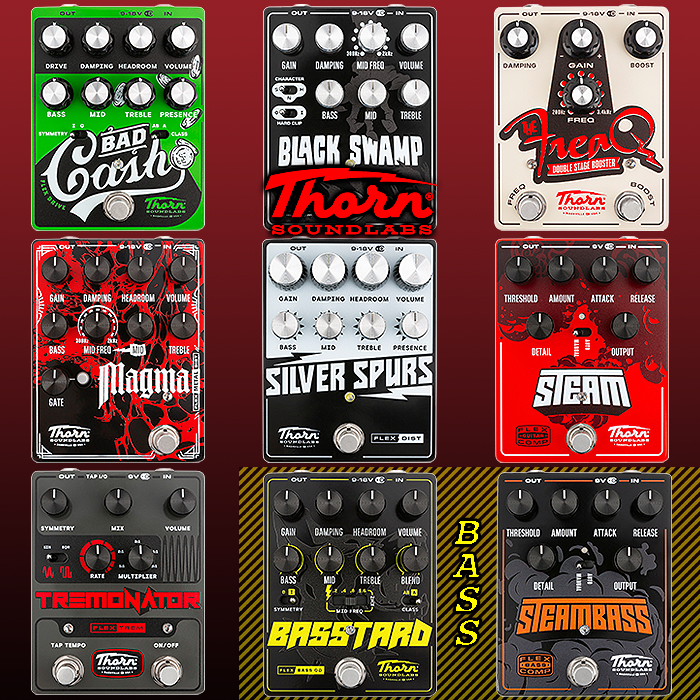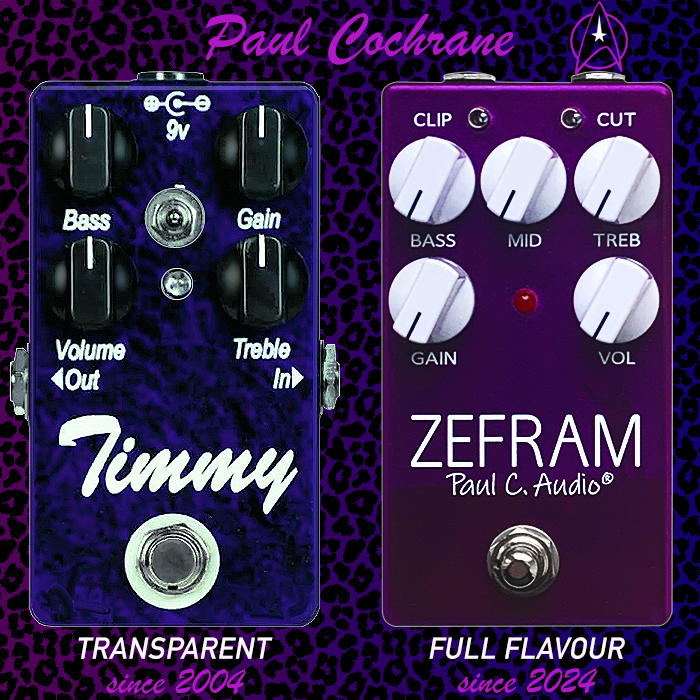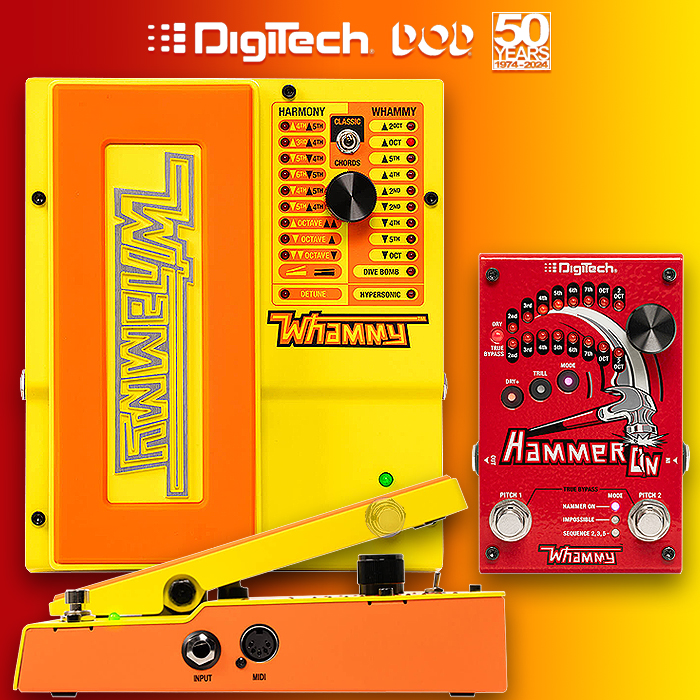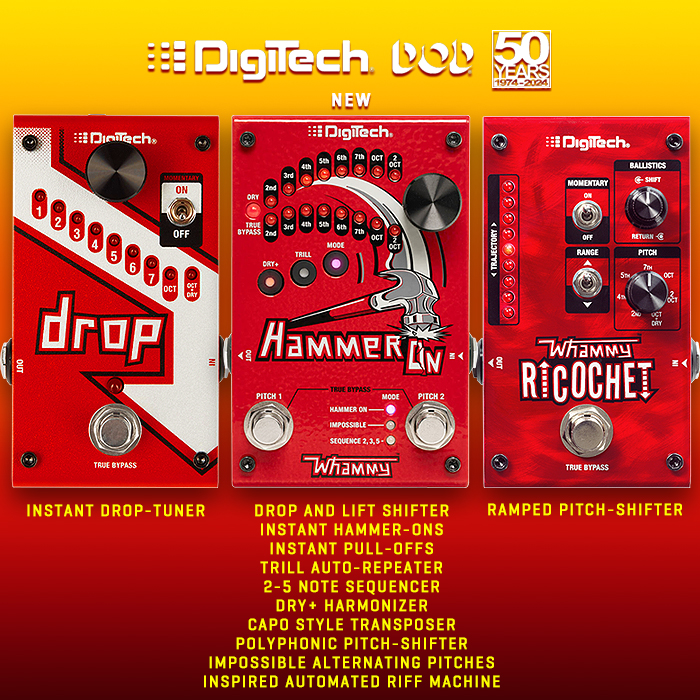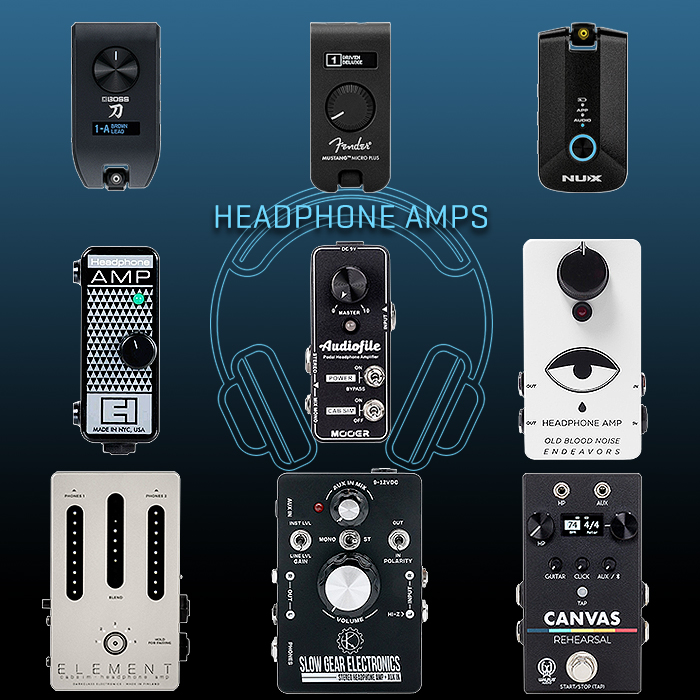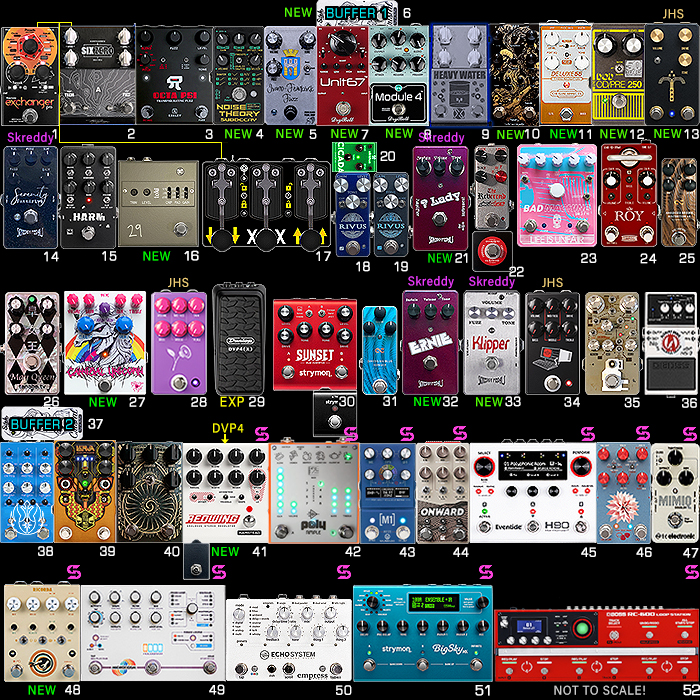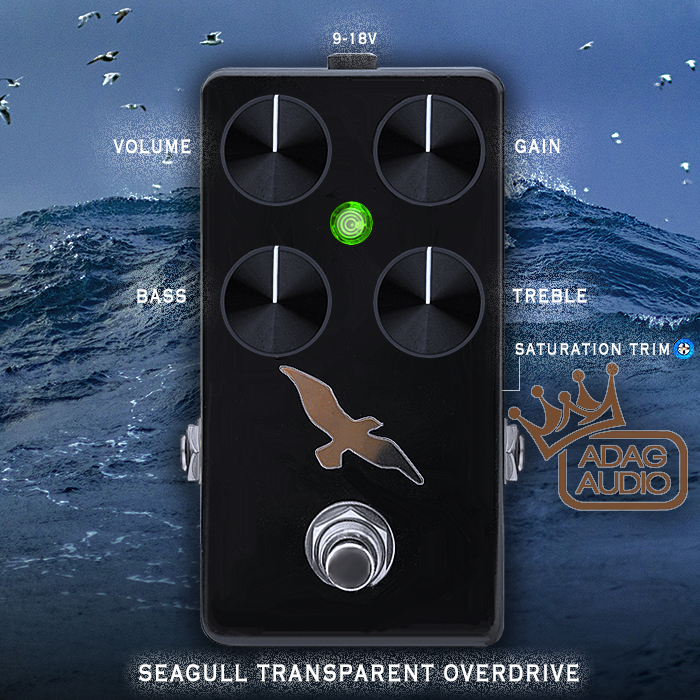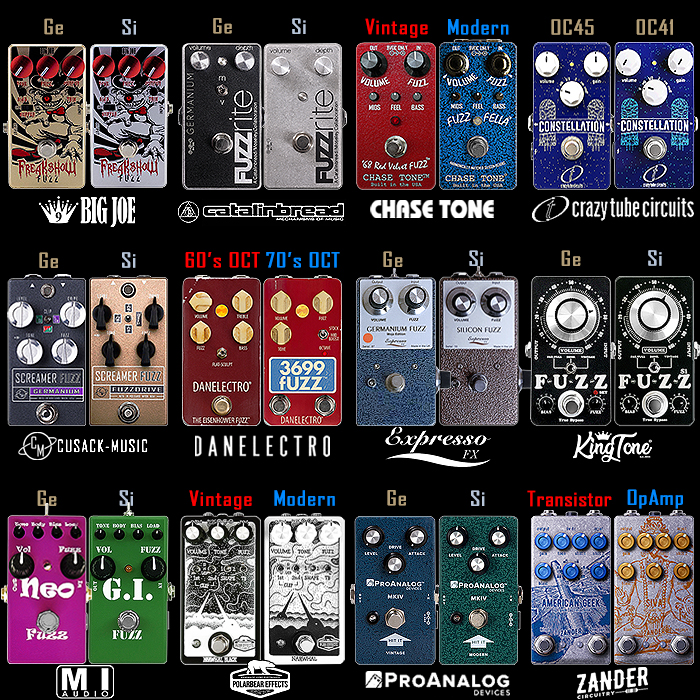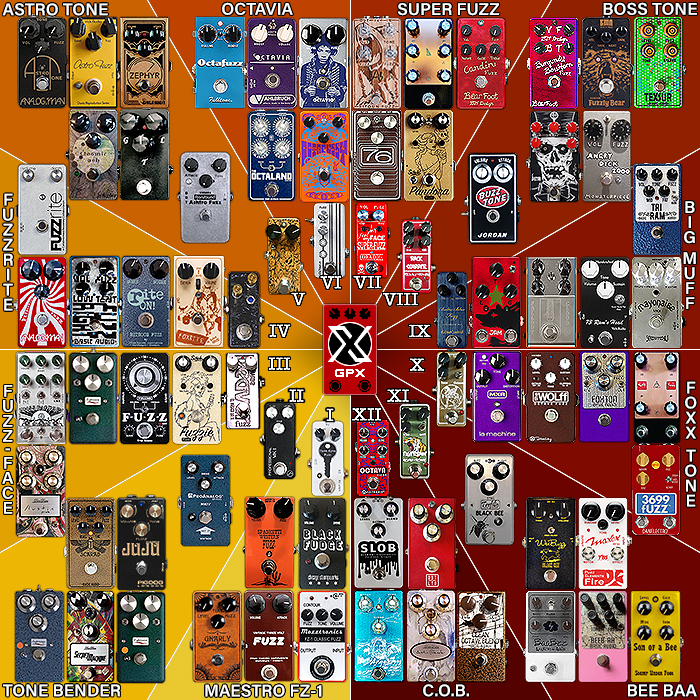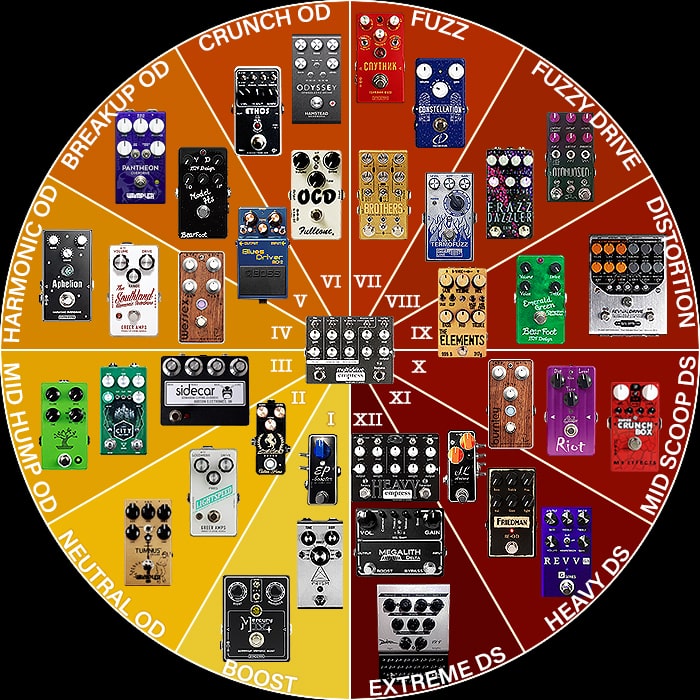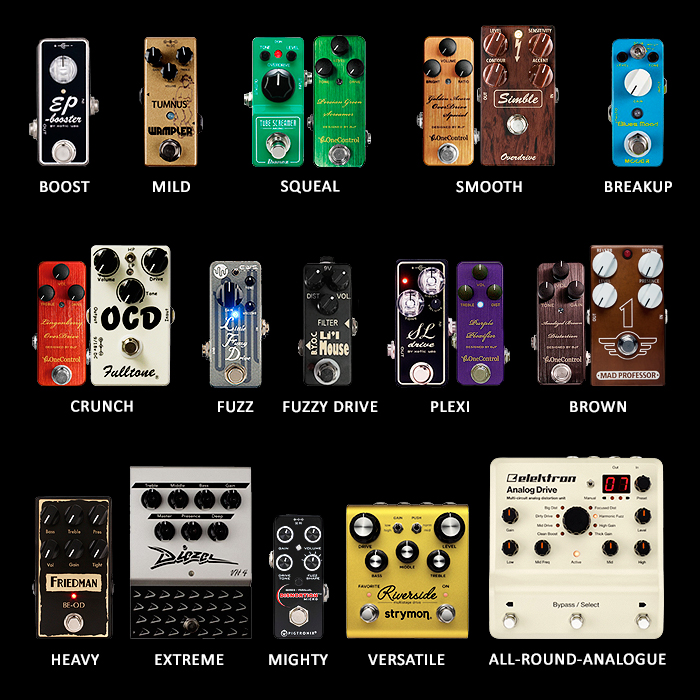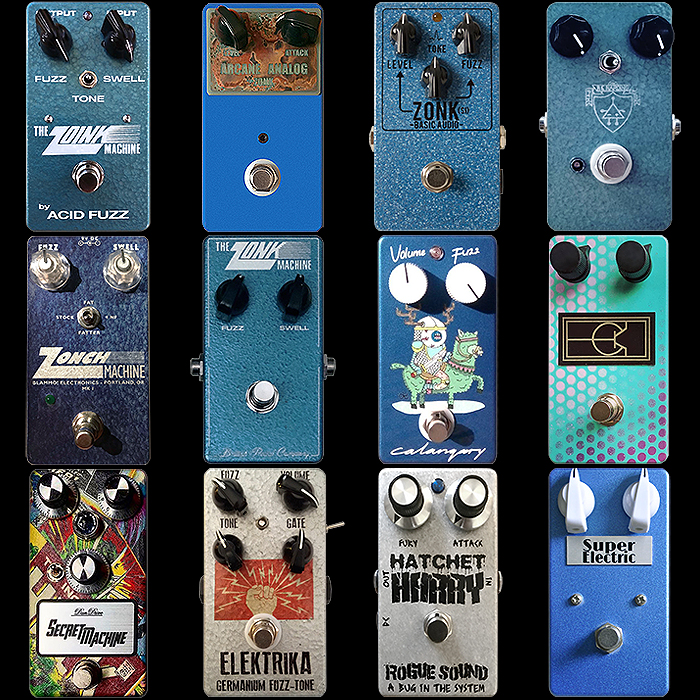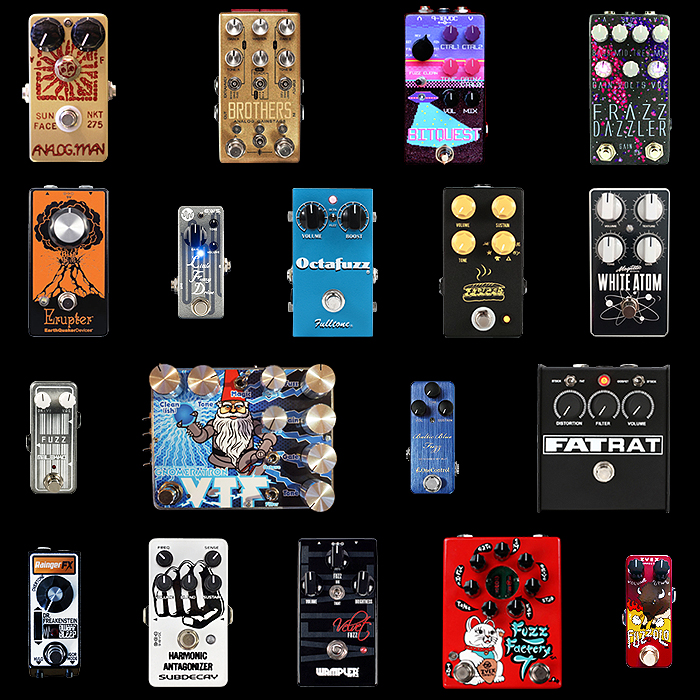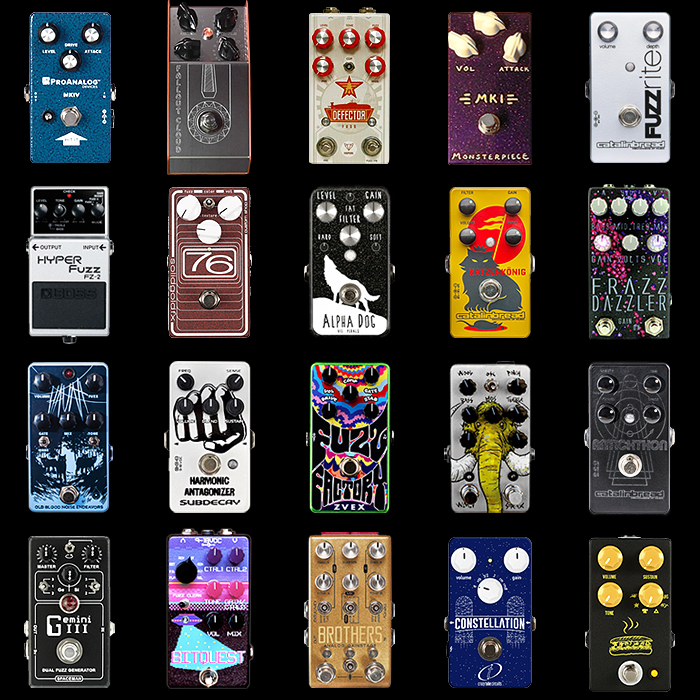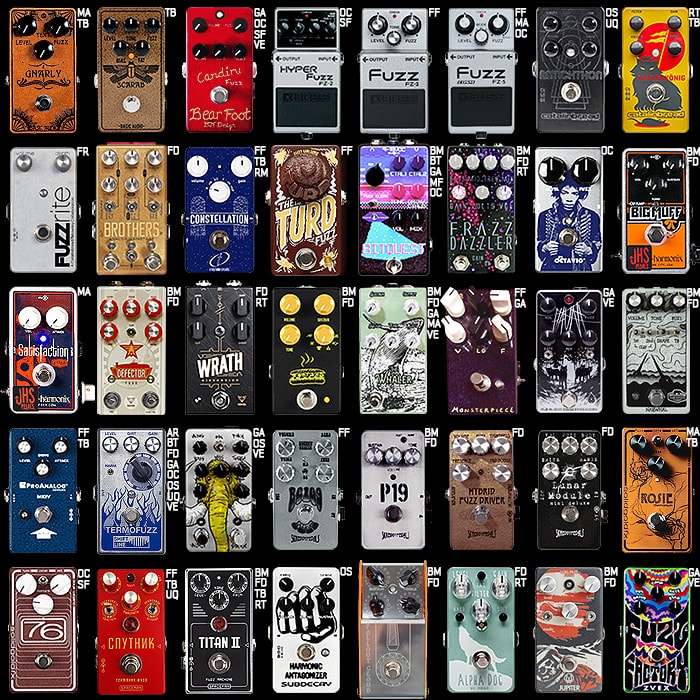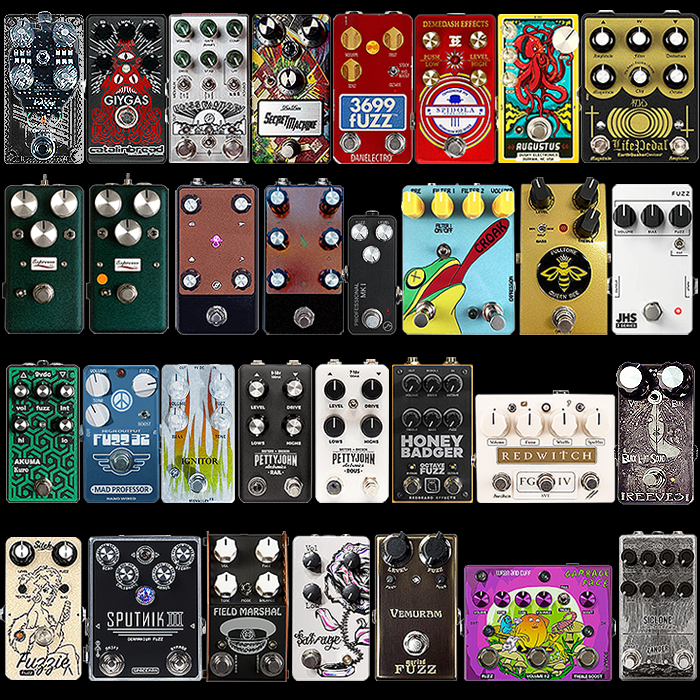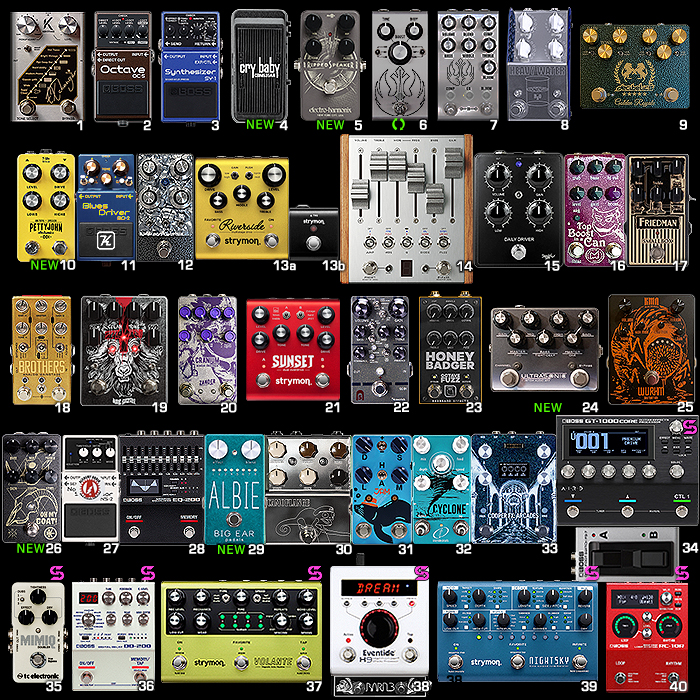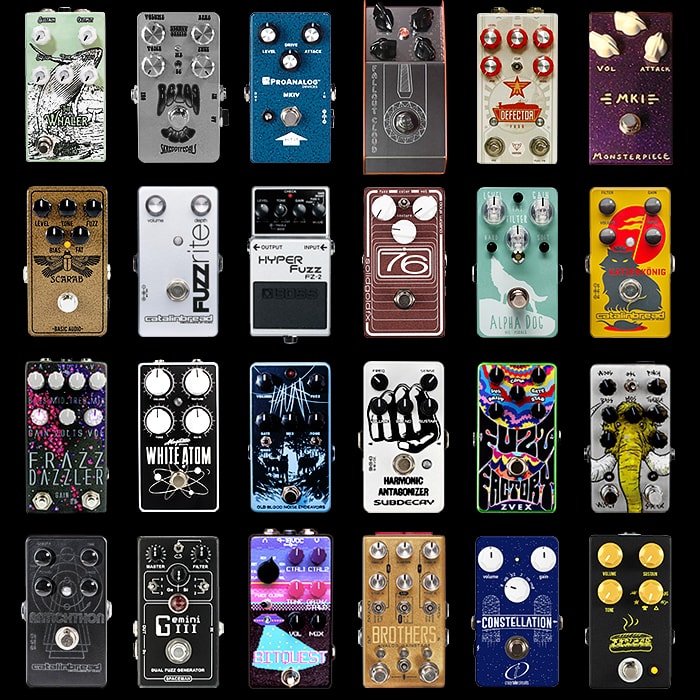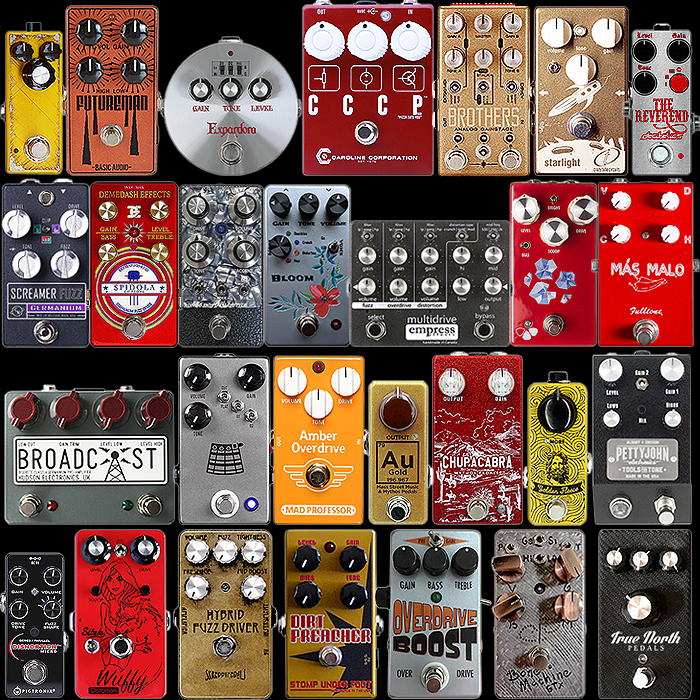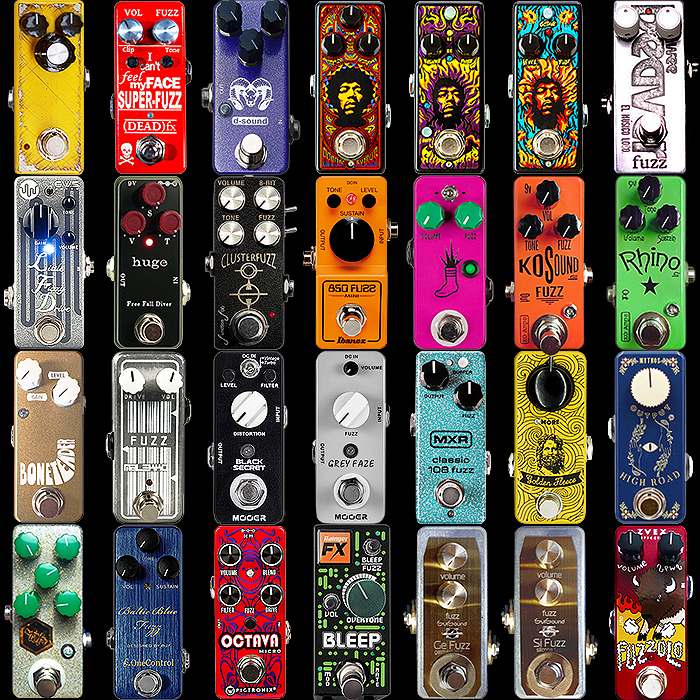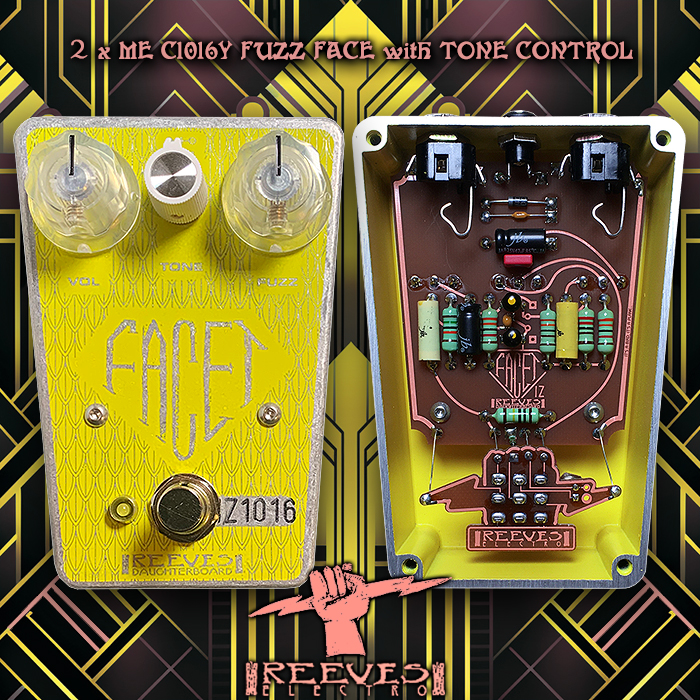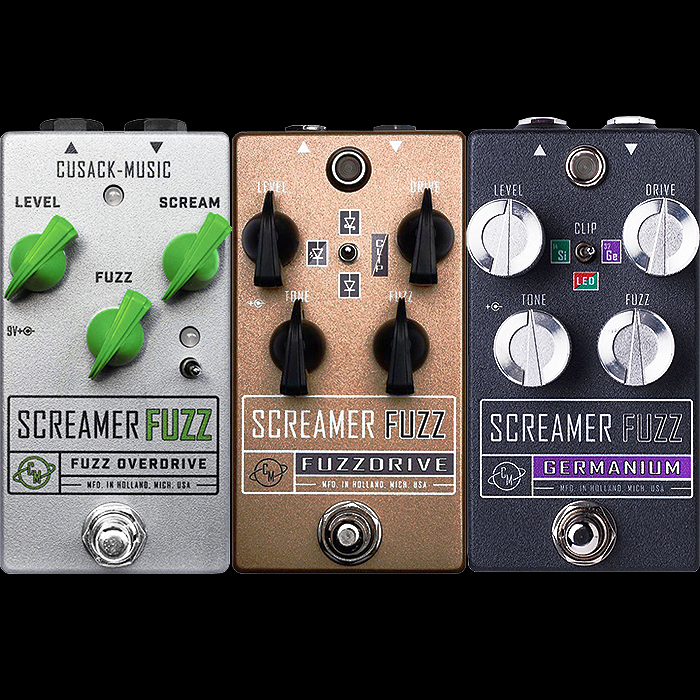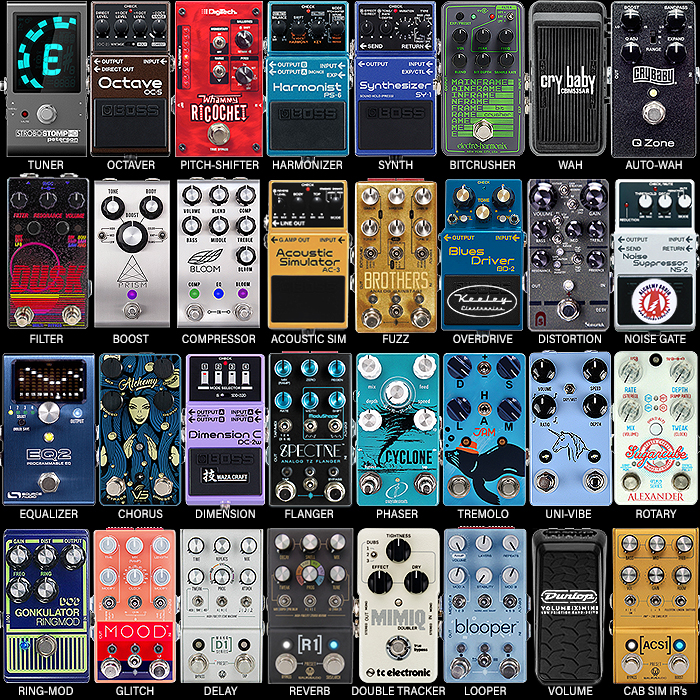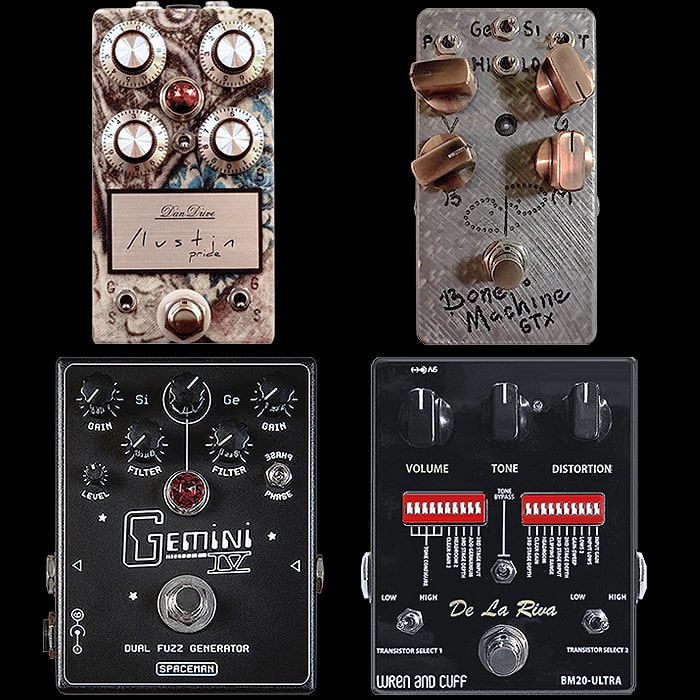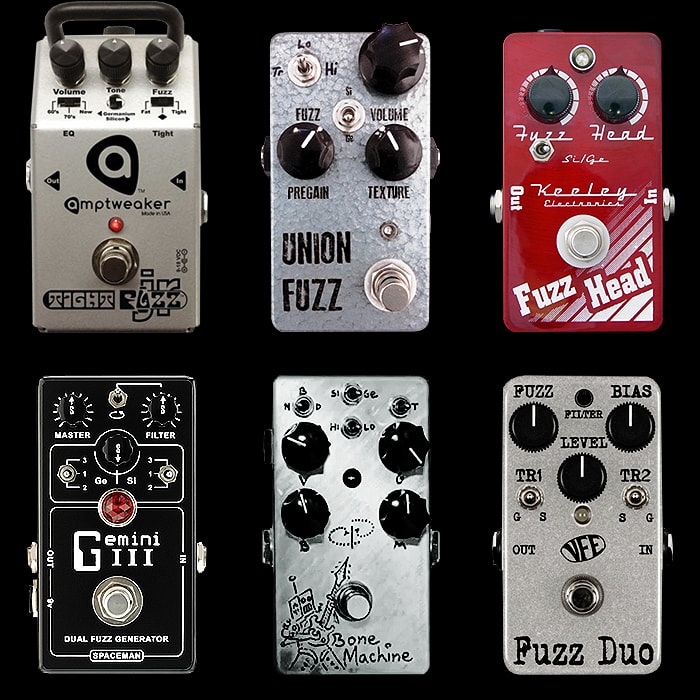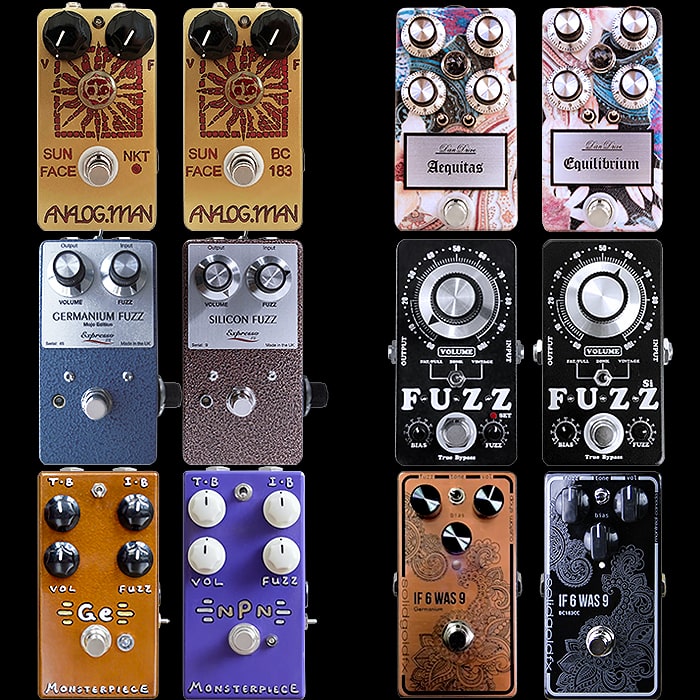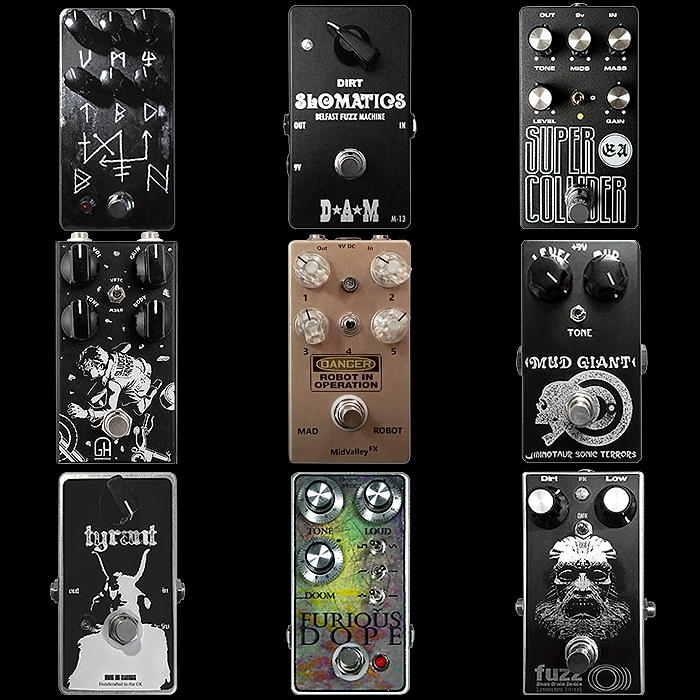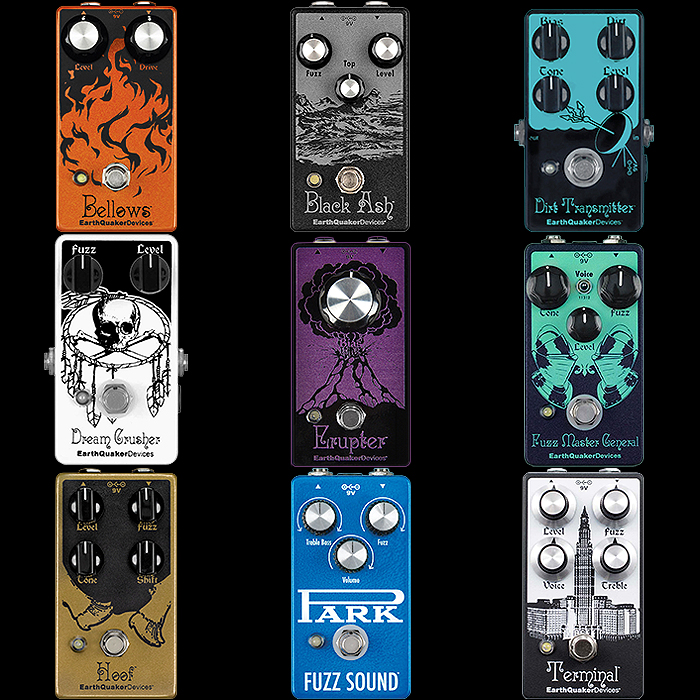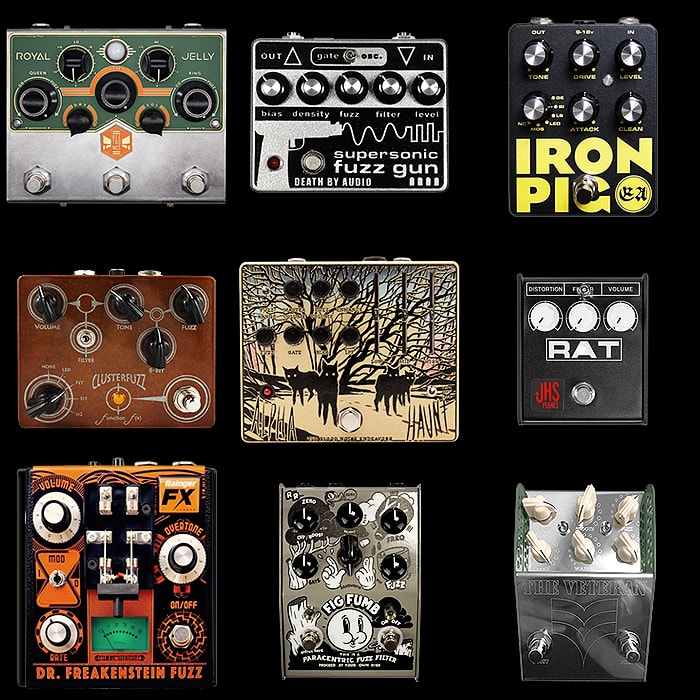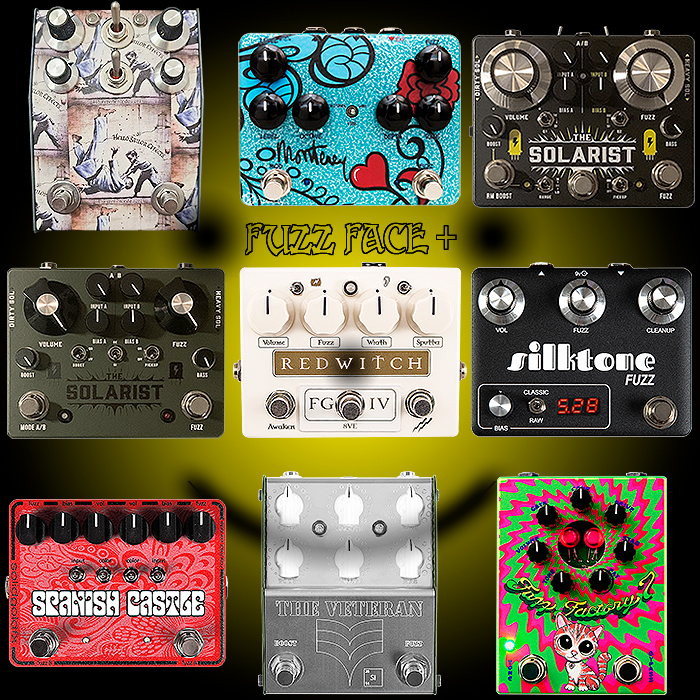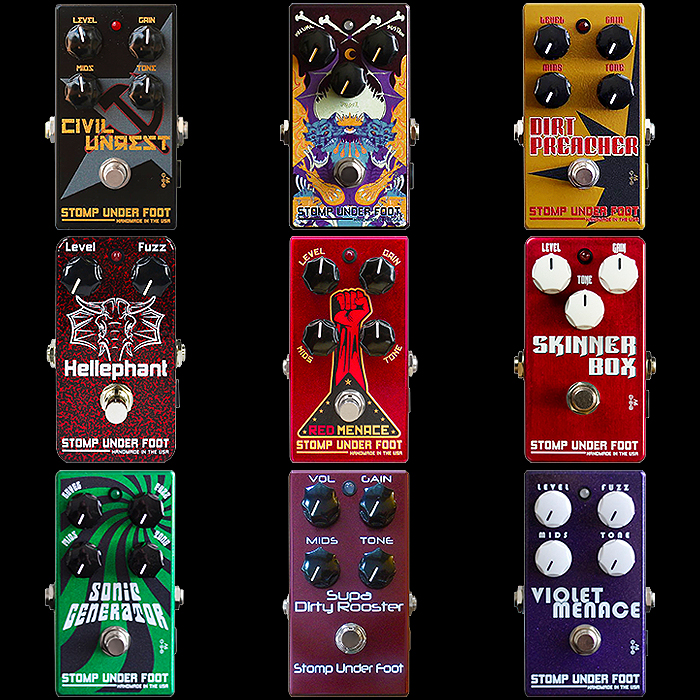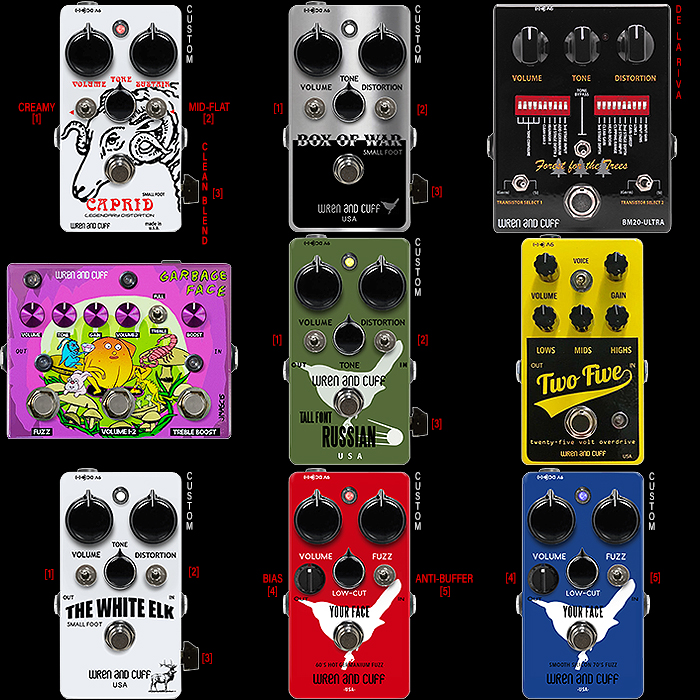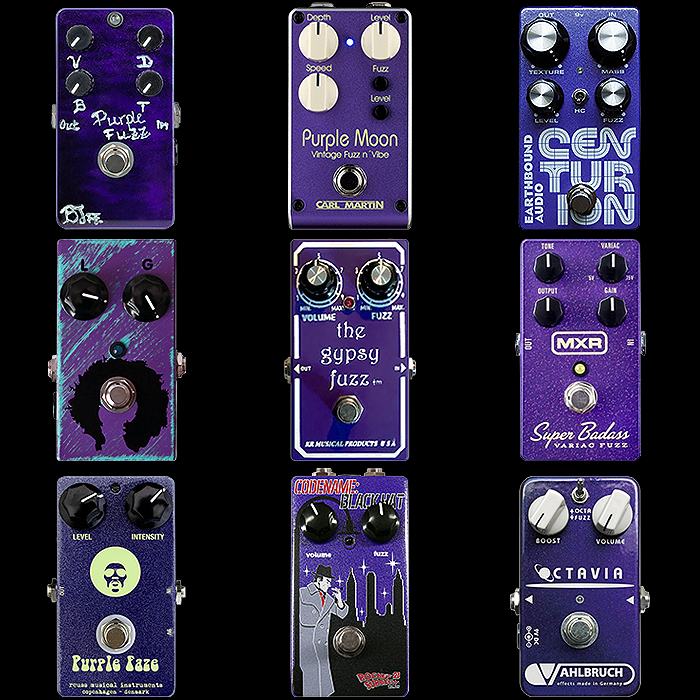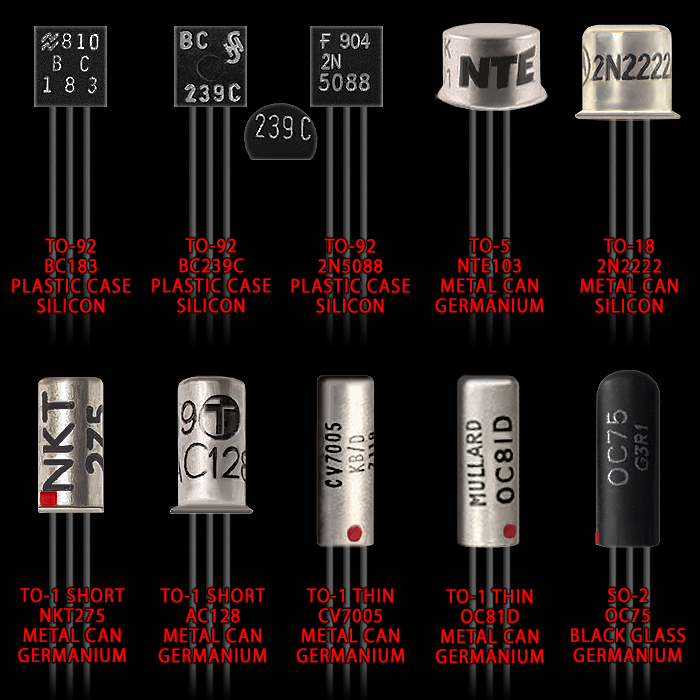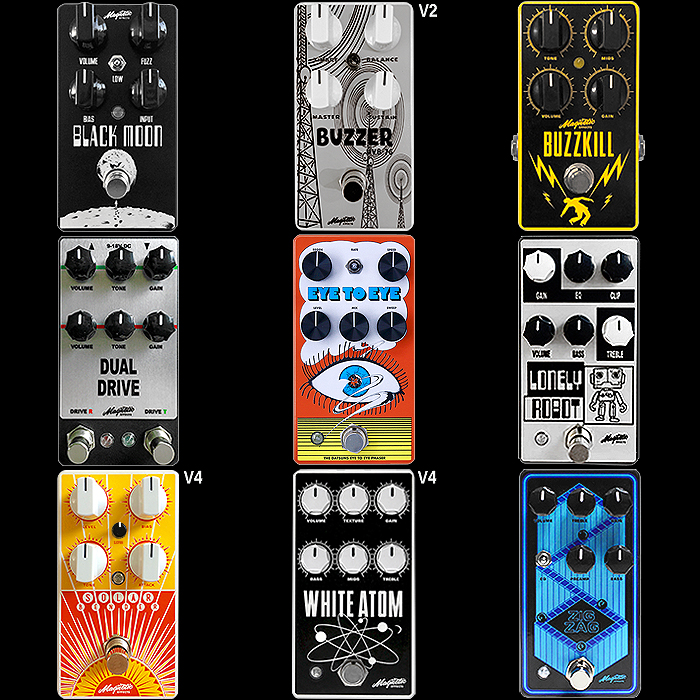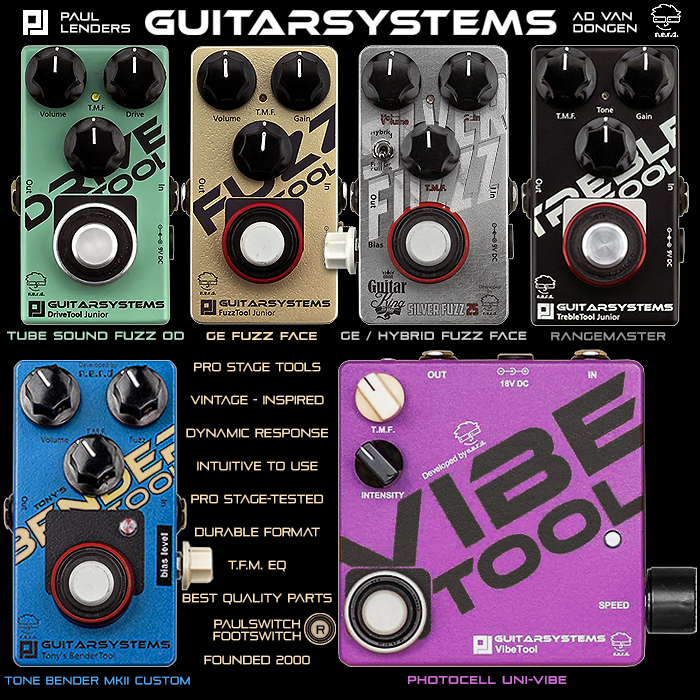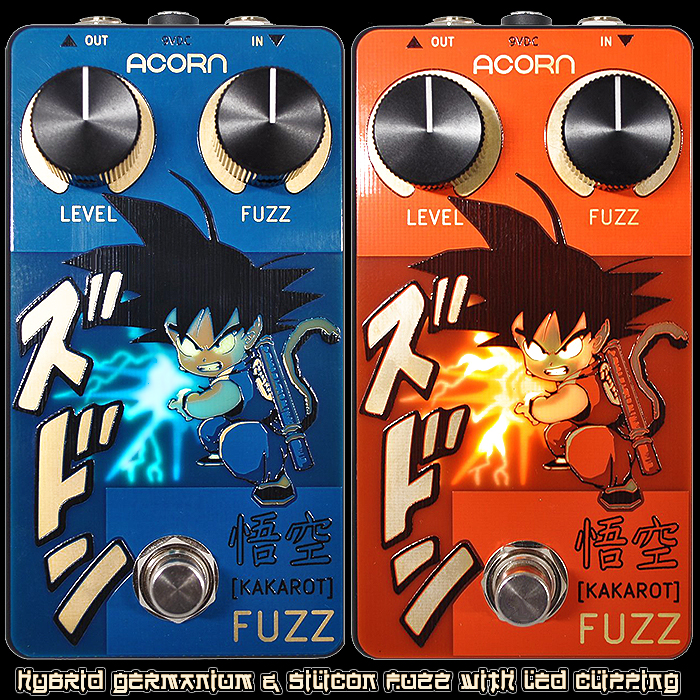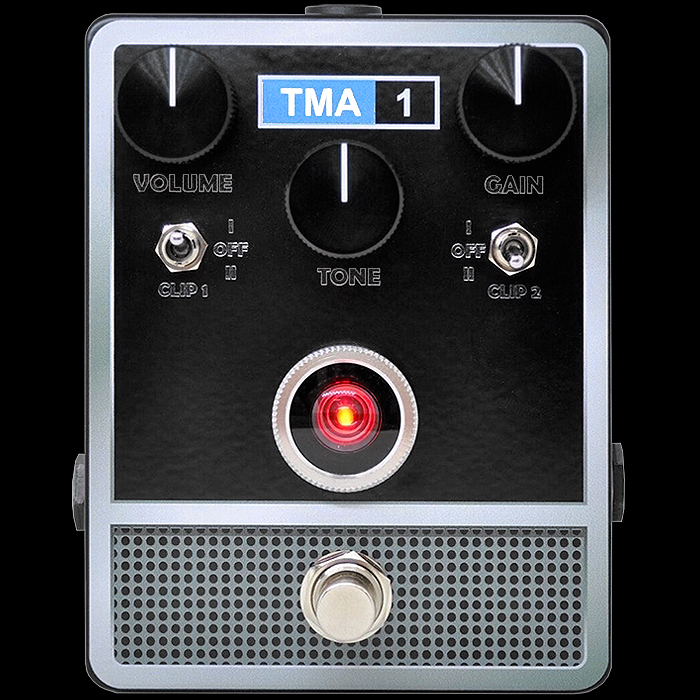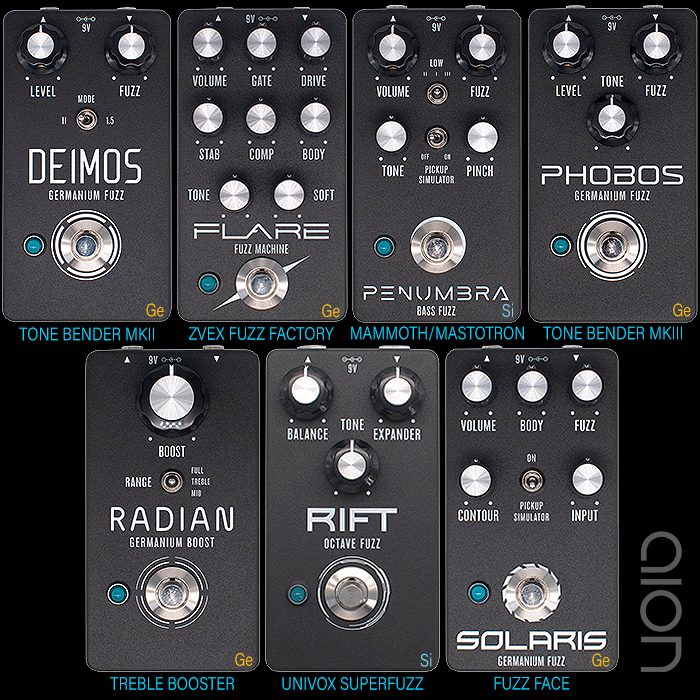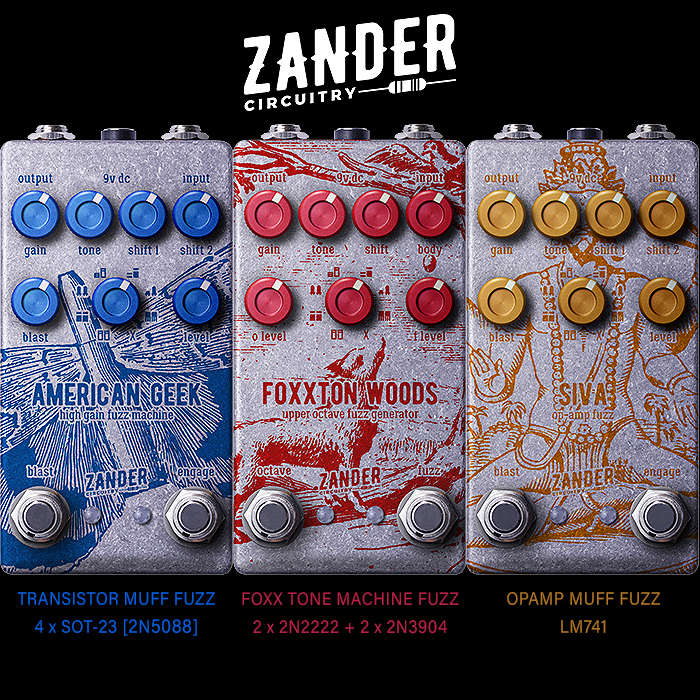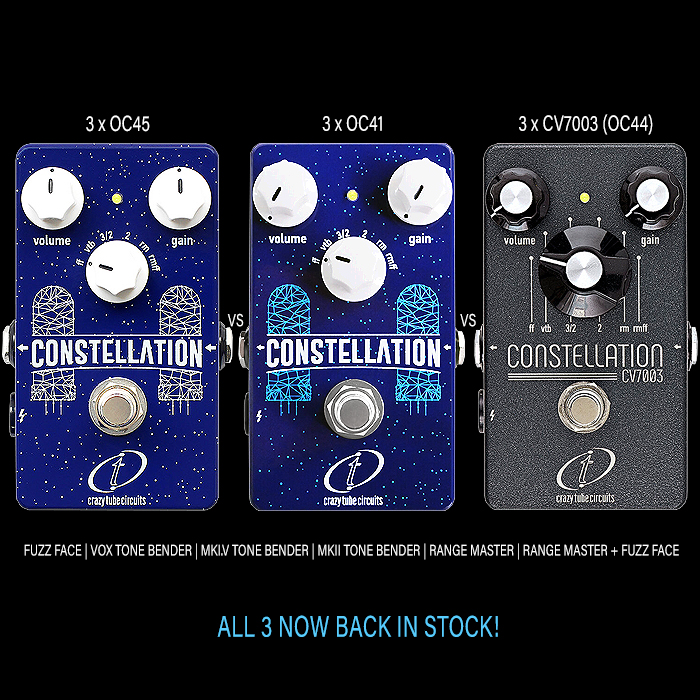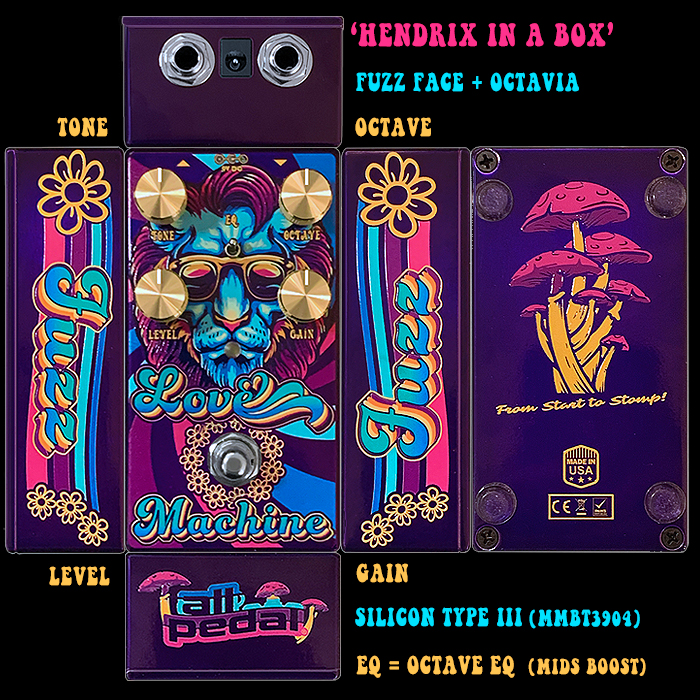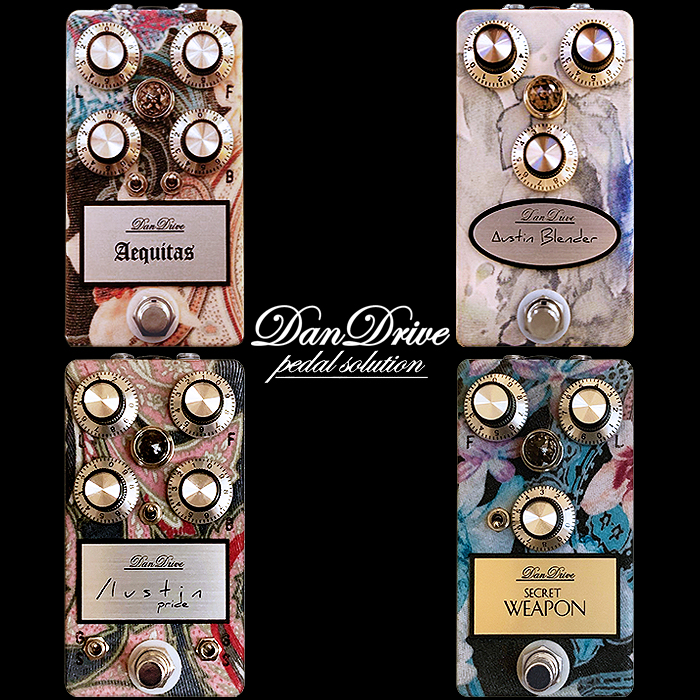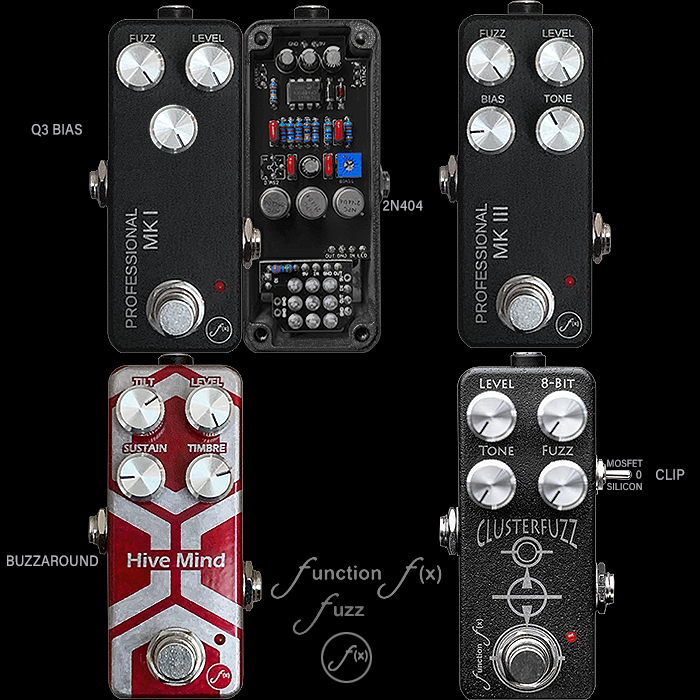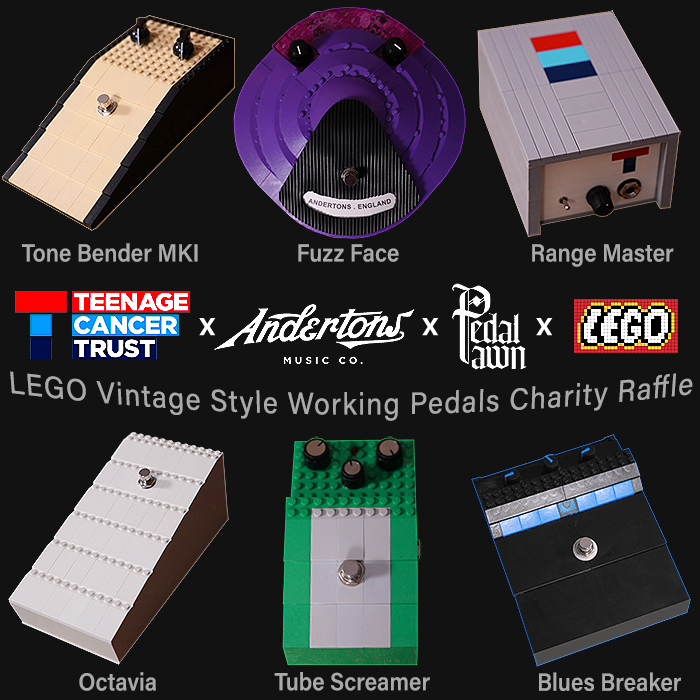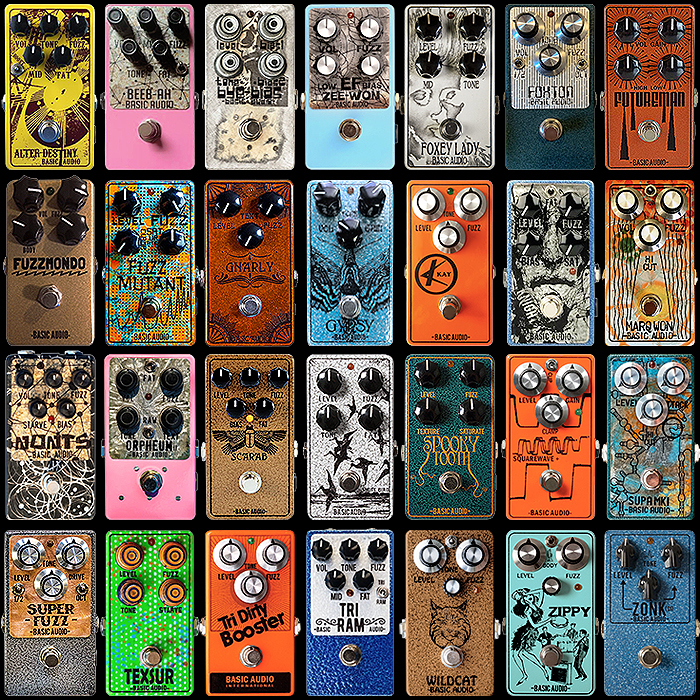The 3 Key Original Fuzz Face Types and Derivations
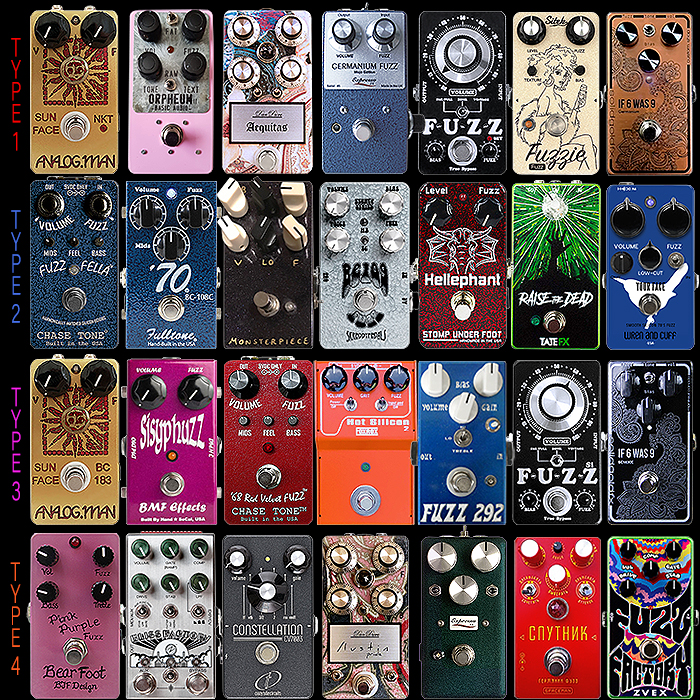
This article has been much requested - following on from my similar takes on the 7 Key Big Muff varieties and 9 Key Tone Bender varieties. I’ve sort of covered this a little bit before courtesy of my 6 Potent Fuzz Face Pairings feature and also my piece on Key Fuzz Transistors, while this offers a more comprehensive and expansive overview.
Everyone knows the story about how Ivor Arbiter of Sound City / Drum City fame sort of adapted the MKI.V Tone Bender format into a mic-stand-base enclosure - and birthed the ’Arbiter Fuzz Face Distortion Unit’ - back in 1966. Notably Ivor Arbiter also designed the Beatles’ famous ’Drop-T’ logo which ever more festooned Ringo Starr’s bass drum!
There are some rumours that the very earliest examples of Fuzz Face were AC128-based, but this has not been properly established, and Mike Piera and colleagues have not come across a single example in all their years of dealing with Fuzz Faces. Interestingly later reissue editions of the Fuzz Face did feature AC128’s, while there seems to be no empirical evidence for them having appeared earlier on.
A key difference to the Fuzz Face was in the choice of transistors - which really was just an opportunistic cost-saving choice. The MKI.V’s typically had 2 x OC75, while the Fuzz Faces had short/stout TO-1 Newmarket NKT275 - which were purportedly cheap copies of the AC125 Transistor. Hence one of the many ironies of Fuzz is that they were often made with cheap and surplus parts as such.
There’s always a significant confusion about vintage Transistors as they were re-labelled, and re-badged, and re-named and re-housed even - so that a legitimate transistor variant could appear in multiple different guises - not unlike those many Sola Sound fuzz boxes which were re-badged and re-labelled for anyone and everyone.
Arbiter Fuzz Face then became the Dallas Arbiter Fuzz Face as the Dallas Company effectively bailed out and took over Ivor’s then faltering business. Dallas became involved in 1967 - while the branding only changed in 1968 - at around the same time the decision was made to switch to more consistently reliable Silicon Transistors.
There were a number of different transistors deployed around the same time - with the BC108’s appearing first, but then also BC183L, BC109, BC109C, and BC209C. And later still we had BC183KA, BC130C, and BC239C. And finally AC128’s for the latest reissues.
Note that nearly all pedals nowadays that purport to have NKT275 transistors - are recent thin-line reissues, and not at all the more sought-after original short/stout proper Newmarket NKT275 varieties.
I very much group Fuzz Faces into 4 Types, as follows :
- Type I Germanium : Newmarket NTK275 and high calibre Germanium Transistor alternatives
- Type II Hard Silicon : BC108C and BC109/C and similar
- Type III Soft Silicon : BC183L and similar
- Type IV Hybrids and Derivations : Various Combinations of Transistors and extended feature set
I have tried to be as varied and expansive in my selections here - while still including most of the usual suspects too. Understandably there is something of an overlap with my Potent Pairings article - that research is obviously still valid. I personally have nearly 60 Fuzz Face type pedals, but only include 18 of my own, 19 if I count my original Constellation OC41 variety.
I’m still a huge fan of this genre, and will undoubtedly acquire a few more in time - even though I really do not need to. Readers will know that Sof at Expresso FX is my go-to-guy for these kinds of Vintage UK style Fuzzes, while I also have a lot of love in particular for John Lyons’ Basic Audio, Marc Ahlf’s Skreddy Pedals, and Dan Querner’s DanDrive Pedal - oh and of course Greg Djerrahian over at SolidGoldFX. Of course there are several other perfectly valid examples out there - these are just my particular best-fit examples!
What we have here is essentially 4 rows - each row featuring a selection of pedals per that type (I to IV), as labelled, and as follows :
Type I Germanium
- Analog.Man Sun Face Newmarket NKT275 Red/White Dot
- Basic Audio Orpheum II Germanium Fuzz - CV7355
- DanDrive Aequitas Germanium Fuzz - AC127
- Expresso FX Germanium Fuzz - CV7005
- King Tone MiniFuzz Germanium - NKT275 Thin-line
- Sitek Fuzzie V2 Germanium Fuzz - GT308V + P416B
- SolidGoldFX If 6 Was 9 Copper Germanium Fuzz - Tesla 106NU70
Type II Hard Silicon
- Chase Tone Fuzz Fella BC108C 70’s Silicon Fuzz
- Fulltone ’70 BC108C Fuzz
- Monsterpiece Scratchy Snatch 6-knob BC108 Silicon Fuzz
- Skreddy Pedals BC109 Silicon Fuzz
- Stomp Under Foot Hellephant Silicon Fuzz - 2N222A
- Tate FX Raise the Dead Silicon Lime Scream Fuzz - 2N3904 + BC547C
- Wren and Cuff Your Face 70s Custom - BC108
Type III Soft Silicon
- Analog.Man Sun Face BC183
- BMF Sisyphuzz Silicon Fuzz - BC183
- Chase Tone ’68 Red Velvet BC183 Silicon Fuzz
- Foxrox Hot Silicon2 Fuzz - BC183 version
- JDM Pedals Fuzz 292 Blue - BC183
- King Tone MiniFuzz Silicon - BC183
- SolidGoldFX If 6 Was 9 Silicon BC183C Fuzz
Type IV Hybrids and Derivations
- Bearfoot FX Pink Purple Fuzz - 2N5952 + BC550C + 2N3108
- Chase Bliss Audio / Zvex Bliss Factory - 2N3904 + 2 x AC128 equivalent
- Crazy Tube Circuits Constellation Germanium Multi-Fuzz - OC41/OC44
- DanDrive Austin Pride Fuzz - 2 x NTE103 + 2 x NTE123
- Expresso FX Dual Fuzz Face Ge/Si Custom - 2 x CV7351 + 2 x CV10806
- Spaceman Effects Sputnik III Germanium Fuzz - 3 x ГТ308В or similar Soviet NOS
- Zvex Vertical Fuzz Factory Germanium Fuzz - 2N3904 + 2 x AC128
Analog.Man Sun Face Newmarket NKT275 Red/White Dot
It's probably right to start with Mike Piera's Analog.Man brand of pedals as he has pretty much become known as probably the world's leading expert on the Fuzz Face genre. He has always offered an extensive range of NOS Transistors - as many as 20 different types at the peak. While dwindling supplies have brought about ever more fierce searches for similarly high calibre NOS Transistors. His proper Newmarket NKT varieties of several stripes - Red Dot, White Dot etc. have pretty much become the benchmark for these reproductions. Obviously most of the most desirable transistors are long gone - and there are a few other builders who might just have a few left of those killer original NOS types. Recent iterations are still undeniably top notch fine, but not quite as desirable as those early classic Newmarket examples.
Basic Audio Orpheum II Germanium Fuzz - CV7355
The CV prefix indicates military applications - and there are some incredible CV variety Fuzz Faces out there - pretty much every bit as good as the Newmarket NKT275 originals. My favourite favourite ones are probable CV7005, while JAM Pedals uses CV7002, and this CV7355 is undeniably excellent too.
DanDrive Aequitas Germanium Fuzz - AC127
DanDrive's Transistor of choice here is typically the AC127, while parts supply being what it is - other equally fine varieties are often substituted too. Dan Querner has build up a very find reputation in a relatively short time-span. I can vouch for the quality and the craft of his build. For Boutique Pedal Builders - you are typically buying into the creator's 'Ears' and Dan most definitely has a fine ear for tone!
Expresso FX Germanium Fuzz - CV7005
Sof at Expresso FX has become my go-to-guy for British vintage style fuzzes - Fuzz Faces and Tone Benders in particular. He also has an incredibly good ear for tone, and some deft touches on the build and finish of those pedals. I particularly like his more recent Custom Varieties in colour-shifting Gørva enclosures. Sof has built me some fantastic fuzzes over the years - and his CV7005 variety is one of my very favourite Fuzz Face types.
King Tone MiniFuzz Germanium - NKT275 Thin-line
Jesse Davey is a 'Brit Abroad' who has done very well for himself with his fine line of extended features King Tone Pedals. Do note that he is using the NKT275 Thine-Line reissues here rather than the original NOS varieties - he still delivers a very fine tone - and that central voicing toggle switch is really genius - as is his smart Biasing circuit. Some of Jesse's pedals can be a little pricey, while they are generally of such a high quality to be worth it. Really smart form factor too.
Sitek Fuzzie V2 Germanium Fuzz - GT308V + P416B
My good friend Andy Sitek is another builder with a refined ear, and a meticulous quality approach to everything he touches. His new Fuzzie V2 variant is really smart and smartly versatile too. You can get some quite distinct textures here that you cannot easily get elsewhere. Super high quality - combined with very reasonable pricing.
SolidGoldFX If 6 Was 9 Copper Germanium Fuzz - Tesla 106NU70
Greg Djerrahian is yet another very fine builder, and I have somehow ended up with 9 of his - including I think all his custom Germanium editions. Simplicity, elegance and quality is what you get here - and this is another very fine Germanium type candidate. Each of mine very much have their own distinct voicings and personalities. I view each of my Germanium Fuzzes as pretty special and unique!
Type II Hard Silicon
- Chase Tone Fuzz Fella BC108C 70’s Silicon Fuzz
- Fulltone ’70 BC108C Fuzz
- Monsterpiece Scratchy Snatch 6-knob BC108 Silicon Fuzz
- Skreddy Pedals BC109 Silicon Fuzz
- Stomp Under Foot Hellephant Silicon Fuzz - 2N222A
- Tate FX Raise the Dead Silicon Lime Scream Fuzz - 2N3904 + BC547C
- Wren and Cuff Your Face 70s Custom - BC108
Chase Tone Fuzz Fella BC108C 70's Silicon Fuzz
Kyle Chase is another master of Fuzz Face - particularly with delivering Germanium-sounding varieties from Silicon Transistors. So this is kind of the opposite to that - a proper harder style Silicon Type II - based on that first type of Silicon Transistor. Very significant extended range here, while I would have preferred to have a little more volume on tap too.
Fulltone '70 BC108C Fuzz
In my 9 Best Fulltone feature I included all of Mike Fuller's Fuzz Pedals - he obviously has a great grasp on those early classics. And this is every bit as good as anything else out there of this type. Really simple and elegant controls, and behaves exactly how you would expect.
Monsterpiece Scratchy Snatch 6-knob BC108 Silicon Fuzz
I would have liked to have had a few more Richard Coibion Monsterpieces by now - in fact this is my only one to-date - acquired from a collector in Singapore. This is a rather unusual 6-knob variety for this Scratchy Snatch type and I am rather fond of it. Another great extended range experience!
Skreddy Pedals BC109 Silicon Fuzz
A smart evolution of Silicon Fuzz Face with clever controls for tuning towards single-coil or humbucker pickups. This is every bit a modern classic, and a great example of this genre. As March Ahlfs states himself - "Ripping high gain oldschool fuzz'!
Stomp Under Foot Hellephant Silicon Fuzz - 2N222A
You will have read that I typically like all my fuzzes of his type to have a 3rd Bias knob - as you can then shift the voicing between gated / ripping to slightly more open and even. While of course there is much less need for actively Biasing these Silicon Transistors, and Matt Pasquerella's 2-knob Hellephant is a very fine example of the genre - with actually a huge amount of variety delivered along the whole taper of the Fuzz control knob.
Tate FX Raise the Dead Silicon Lime Scream Fuzz - 2N3904 + BC547C
I have a few one-knob fuzzes, and the combination of ripping sounds and obviously appealing artwork here is a surefire winner for me. I was lucky enough to snag a Lime Green edition of Stuart Tate's still flagship pedal. There are a number of great one-knob Silicon Fuzz Faces out there - but this for me is about the pinnacle!
Wren and Cuff Your Face 70s Custom - BC108
Wren and Cuff's Matthew Holl is yet another Fuzz Master - I have his Custom Caprid, and really smart De La Riva multi-switching fuzz. I have determined that I will probably acquire each of his custom versions eventually - including this fully loaded Your Face Custom Fuzz. Weirdly the standard Silicon Your Face comes in somewhat contrary Red enclosure - so I have immediately remedied that by selecting Blue enclosure and Blue LED - really as it should be!
Type III Soft Silicon
- Analog.Man Sun Face BC183
- BMF Sisyphuzz Silicon Fuzz - BC183
- Chase Tone ’68 Red Velvet BC183 Silicon Fuzz
- Foxrox Hot Silicon2 Fuzz - BC183 version
- JDM Pedals Fuzz 292 Blue - BC183
- King Tone MiniFuzz Silicon - BC183
- SolidGoldFX If 6 Was 9 Silicon BC183C Fuzz
Analog.Man Sun Face BC183
This is pretty much carried directly over from my Potent Pairings feature - and pretty much deservedly so. Mike Piera has a very finely tuned ear for these sorts of fuzzes - and all of his builds are fantastically calibrated and refined before being shipped to customers. There are lots of very decent Fuzz Faces out there nowadays, but in many ways Analog.Man still continues to be the benchmark.
BMF Sisyphuzz Silicon Fuzz - BC183
While I cannot find any direct documentary evidence to confirm that these are indeed BC183 transistors - the Sisyphuzz is very much billed as being as closely matched in texture and tone to those Germanium originals. So very much a Type III category Fuzz Face - going for that slightly softer and warmer Germanium style of Fuzz Face tone. I have alas acquired none of Scott Kiraly's pedals to date - something I obviously need to remedy soon as!
Chase Tone '68 Red Velvet BC183 Silicon Fuzz
This is Kyle Chase's Bona Fide Classic - and is typically the poster-child for this Type of Germanium-sounding fuzz. Kyle has built a very find reputation over the years in being able to eke out very convincing Germanium-styles tones and textures - from those BC183 types Transistors.
Foxrox Hot Silicon2 Fuzz - BC183 version
Dave Fox's pedals have always been in my peripheral vision. I originally dismissed them a touch because of their slightly old-school looks, but have over the years come around to a very favourable opinion of these - it just hasn't quite happened yet. Dave is very famous for his Captain Coconut 'Hendrix in a Box' concoction - somewhat oversized though, and particularly when compared to Keeley's Monterrey example of the same kind of concept. Lots of Dave's pedals are undeniably great sounding and one or two will surely find their way into the collection - actually with the CC Hybrid2 the forerunner in that selection. For this Silicon2 variety you have a choice of 4 transistor types, including BC183L. While the above demo and most of these editions tend to have BC108 and similar.
JDM Pedals Fuzz 292 Blue - BC183
I consider Joe Doctermann a good friend now, and have a couple of his - where I again really should have a few more by now. He does a great line in fuzzes - smartly modernising where he can, while maintaining all the vintage goodness. His 292 Blue enclosure houses a number of different Silicon Transistors - including of course the softer BC183 variety too as here. I have pictured my preferred iteration of this pedal which also features a small Tone trimpot on the pedal surface!
King Tone MiniFuzz Silicon - BC183
This is of course Jesse Davey's companion fuzz to his above NKT275 variety. This has been on my wishlist for a while - as I do like to complete by sets! Another classic take on this style of fuzz - with the added voicing features of course for extra versatility. Still a little pricey, but mostly worth it. I will undoubtedly add this one too one of these days, while it's more of a backlog type thing right now rather than a pressing priority - so may not happen particularly quickly therefore.
SolidGoldFX If 6 Was 9 Silicon BC183C Fuzz
The final reference to one of my Potent Pairings is this Greg Djerrahian variety. I in fact have all 3 of Greg's compact Fuzz Face varieties and each is an excellent example of the type. Note that there are different styling and enclosure colour choices here which can be a little confusing - generally though these are just 3 distinct varieties!
Type IV Hybrids and Derivations
- Bearfoot FX Pink Purple Fuzz - 2N5952 + BC550C + 2N3108
- Chase Bliss Audio / Zvex Bliss Factory - 2N3904 + 2 x AC128 equivalent
- Crazy Tube Circuits Constellation Germanium Multi-Fuzz - OC41/OC44
- DanDrive Austin Pride Fuzz - 2 x NTE103 + 2 x NTE123
- Expresso FX Dual Fuzz Face Ge/Si Custom - 2 x CV7351 + 2 x CV10806
- Spaceman Effects Sputnik III Germanium Fuzz - 3 x ГТ308В or similar Soviet NOS
- Zvex Vertical Fuzz Factory Germanium Fuzz - 2N3904 + 2 x AC128
Bearfoot FX Pink Purple Fuzz - 2N5952 + BC550C + 2N3108
Björn Juhl always has a smart take on a particular genre - and his Hybrid Transistor Fuzz Face variety is engineered for versatility and stability. That 2-Band EQ is also excellent for getting different tones and textures and there are a number of elegant overdrive voicings to be found here.
Chase Bliss Audio / Zvex Bliss Factory - 2N3904 + 2 x AC128 equivalent
I've always said that the Fuzz Factory was a natural extension of the Fuzz Face - with added controls. This is obviously the ultimate take on that - adding in a resonant filter, more EQ and more texture controls. I warned at the time that some people would not get on with this pedal - and indeed there are a number of natural casualties - not just scalpers on Reverb.com. If you know your way around a Fuzz Factory - then this is a lot more flavours and textures on that same theme. Exactly as I expected and a truly fantastic Germanium Fuzz Face to boot!
Crazy Tube Circuits Constellation Germanium Multi-Fuzz - OC41/OC44
I actually have the earlier Blue OC41 version of this Constellation Multi-Fuzz - Fuzz Face / Tone Bender / RangeMaster. CTC are dab hands at creating smart fuzz circuits - and I'm heavily considering getting the newer OC44 slightly rarer Transistor edition. We'll see how that goes - depends what kind of price I can get it at to a large degree. But make no mistake this is a fantastic one of a kind fuzz pedal.
DanDrive Austin Pride Fuzz - 2 x NTE103 + 2 x NTE123
I love fuzz pedals where you can switch and combine transistors creatively so Si + Si, Ge + Ge, Si + Ge, and Ge + Si. This is essentially an updated and upgraded César Díaz Texas Square Face Fuzz. I was very lucky to get an edition with those rare NTE103 and NTE123 transistors - this is all the Fuzz Face varieties you need in a single pedal!
Expresso FX Dual Fuzz Face Ge/Si Custom - 2 x CV7351 + 2 x CV10806
www.instagram.com/p/B-fGlSJHleg/
This is another sort of similar and equally solid take on a Hybrid Switching Fuzz Face - of course with slightly different Transistors - but sounds every bit as good. These two pedals in a row are the perfect vehicle for those who want to capture all the potential Fuzz Face goodness in a single pedal - with 4 distinct voicings based on those permutations.
Spaceman Effects Sputnik III Germanium Fuzz - 3 x ГТ308В or similar Soviet NOS
This is another long term favourite of mine - essentially Germanium Fuzz Face in nature with those beatiful searing Soviet Transistors. Here it throws some extra special soce on top with its Drift/Scan/Scrambler modulation and phase inversion. In the Red Cyrillic enclosure this is something of a legendary pedal!
Zvex Vertical Fuzz Factory Germanium Fuzz - 2N3904 + 2 x AC128
Of course I could not leave out the original and one of the most significant of the Fuzz Face evolutions. Starting off with a basic Fuzz Face - Zachary Vex then expanded the scope of the pedal by adding voltage control - Stability, Compression, and a sort of Gating Bias. This pedal can be a little temperamental - particularly if you don't know what you're doing. And you usually need to adjust several parameters in tandem. Once you get the hang of it though it opens up a whole new territory not afforded to your more vanilla Fuzz Face Types.
Final Thoughts
I will always emphasize that these are my own choices and preferences - and they won't necessarily entirely align with your own tastes. That said, these are generally considered some of the most well-known and celebrated varieties and most already have legions of fans and advocates.
I tend to lean a little more towards extended range - and I love it when I can access a whole variety of new sounds. That said - many players really want to keep things simple - so I've tried to give you options - while staying true to my core philosophy.
The ones I have here personally from this selection are :
- Basic Audio Orpheum II
- Expresso FX Germanium Fuzz
- King Tone Fuzz Mini
- Sitek Fuzzie II
- SolidGoldFX If 6 Was 9 Custom Copper Germanium
- Chase Tone Fuzz Fella
- Monsterpiece Scratchy Snatch 6K
- Skreddy BC109
- Stomp Under Foot Hellephant
- TateFX Raise The Dead
- Chase Tone '68 Red Velvet Fuzz
- SolidGoldFX If 6 was 9 BC183CC
- Bearfoot FX Pink Purple Fuzz
- Chase Bliss Audio Bliss Factory Fuzz
- Crazy Tube Circuits Constellation Multi-Fuzz - Original OC41 edition
- DanDrive Austin Pride Fuzz
- Expresso FX Custom Ge/Si Switching Fuzz
- Spaceman Sputnik I
- Zvex Vertical Fuzz Face Germanium
Those are barely 1/3 of all Fuzz Faces that I own - and there's plenty more varieties out there that are equally worthy and valid. All these fuzzes are beautifully tuned and calibrated - and are indeed some the finest examples of their kind.
Every other maker has a Fuzz Face in their range or past history, and this classic 2-transistor fuzz type, with its wonderful guitar volume cleanup potential, is as endearing today as it ever was. And while I am a fuzz eclecticist - many players will only handle this style of fuzz as they really like to have the dynamic quality embedded here - and which does not exist for many other fuzz varieties.
I'm not the slightest bit fond of the early mic-stand discus-shaped enclosures - which are as over-sized, unwieldy and impractical as they could be. I love vintage circuits - but in proper modern and more compact enclosures. Be aware also that traditionally there is a problem with output volume on a lot of Fuzz Faces - so bear that I'm mind when you're making an acquisition.
Note that you could also argue that there is a Type V - in the guise of the much doomier D*A*M Meathead style of 2-Transistor Fuzz. That boomy low-end though rather makes it a separate category for me - as these don't really sound too much like those classic 3 Fuzz Face types. So I feel entirely justified in leaving those out here - you can see a selection of those in the related Doom Drone Sludge Fuzz article.
I would love to hear from you readers as to what your own personal favourite Fuzz Face varieties are - I'm not so much interested if those choices are discus-shaped or otherwise unnecessarily over-sized! In fact Dave 'Pickdropper' Friesema does an excellent THT Germanium Mini Fuzz Face utilising 2N404 Transistors. There really is no need for those big boxes!







